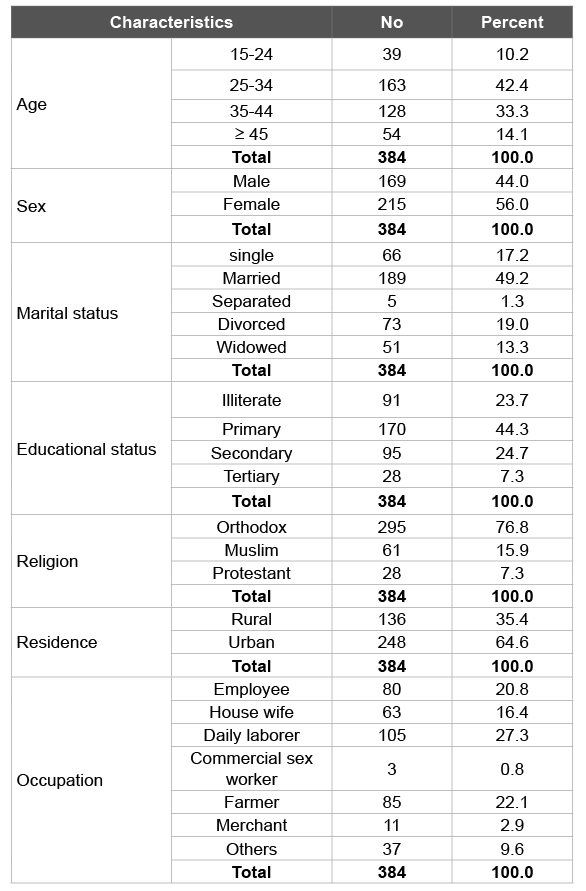
Table 1: Socio-demographic characteristics of adult HIV patients started ART from September 2010 to August 2011 in AHMC ART clinic, Oromia regional state, Ethiopia.

Tilaye Workneh Abebe1 Tolossa Eticha Chaka2 Girma Mulisa Misgana3* Abebe Megerso Adlo1
1Department of Public Health, Adama Hospital Medical College, Adama, Ethiopia*Corresponding author: Girma Mulisa Misgana, Adama Hospital Medical College, P.O. Box: 84, Adama, Ethiopia, Tel: +251911928774; E-mail: girmamulisa30@gmail.com
Background: Acquired immune deficiency syndrome (AIDS) is one of the leading causes of mortality in sub-Saharan Africa. Successful use of Anti-retroviral treatment (ART) suppresses Human immunodeficiency virus (HIV) replication; consequently slowing down disease progression, improving immunity and delaying mortality. Even though ART was implemented long ago, improvement in survival among patients was not adequately determined in institutions providing this service. Thus, the aim of this study was to assess determinants of survival among adult patients on ART in Adama Hospital Medical College, Oromia regional state, Ethiopia.
Method: A retrospective cohort study was employed among 384 clients selected by systematic random sampling method from clients enrolled for antiretroviral therapy from September 2010 to August 2011 in Adama Hospital medical College. The cohort was followed for three years. Descriptive statistics was used to summarize socio-demographic variables. Kaplan-Meier survival analysis was used to estimate survival probability after antiretroviral treatment initiation and Cox-proportional hazard model was used to identify predictors of mortality using SPSS Version 20.
Result: A total of 384 ART naïve adult patients who were initiated on ART were followed for 3 years. About 61% of the participants had baseline CD4 count <200 cells/µl and 76% of them were WHO clinical stage 1 or 2. Fifty-nine percent of participants completed the survival period. Over the 3 years of follow up, 384 patients contributed 792.4-person years of observation (PYO) with the mortality rate of 2.1/100 PYO. The median survival time for the cohort was 24 months while that of dead and lost to follow up (LTF) cases were 1 month and 3 months respectively. The predictors of mortality using the real case assumption model were functional status (ambulatory and bed ridden) and World Health Organization (WHO) clinical stage (3/4). In using worst-case assumption, lack of formal education, divorced marital status, and functional status (ambulatory and bedridden) were predictors of mortality.
Conclusion: More than half of the participants were females and higher proportion of females were younger than 35 years. Higher proportion of the study participants were initiated on ART at advanced disease stge. Death and LTF occurred within the first 3 months of follow up. Thus, to increase the survival of patients on ART, strengthening screening program for early initiation of ART and increasing awareness on early treatment seeking are essential.
Survival; Determinants of survival; ART
Acquired immune deficiency syndrome (AIDS) is one of the leading causes of mortality in sub-Saharan Africa and the full onslaught of the epidemic would not be felt until 2006, when more than 2.2 million people died each year from AIDS-related causes. This region remains most severely affected, with nearly 1 in every 20 adults (4.9%) living with human immunodeficiency virus (HIV) and accounting for 69% of the people living with HIV worldwide. The prevalence of HIV infection is nearly 25 times higher in sub-Saharan Africa than in Asia [1-3].
The revolution in HIV treatment brought about by combination antiretroviral therapy in 1996 had forever altered the course of disease among those living with HIV in high-income countries but had only reached a fraction of people in low and middle-income countries, which bore 90% of the global HIV burden [4]. Even though the service of Antiretroviral treatment (ART) had short history in Africa, the reduction of death and improving the quality of life for people living with HIV/ AIDS (PLWHA) had shown significant advantage. Successful use of ART suppresses HIV viral replication, consequently slowing down disease progression, improving immunity and delaying mortality. Even if ART is not a cure, it prolongs and enhances the quality of life [5].
According to the Federal HIV/AIDS prevention and control office (FHAPCO) single point estimate for prevalence of HIV/AIDS in Ethiopia, the adult HIV prevalence for 2007 is estimated 2.1%. The urban prevalence is 7.7% which is nearly nine times higher than the rural dwellers (0.9%). The estimated number of people living with HIV is 977,394, of which 258,264 are in need of ARV treatment [6].
Since the advent of the ART program, more than 200,000 people have started on treatment in about 500 health facilities throughout the country. Rapid ART service expansion was achieved (from four in 2003 to 517 health facilities in 2009). Accordingly, the number of people accessed to ART increased substantially from 900 in 2003 to 211,000 in 2009 [7].
Despite challenges, Ethiopia continues to make progress in the fight against HIV/AIDS epidemic. More recent national estimates indicate 55.6 percent of PLWHA are on ART as of 2010. A total of 511 health facilities (142 hospitals and 369 health centers) currently provide ART [8]. A number of studies were conducted on determinants and survival time among adult patients on ART [9-11]. However, the survival time of patients on ART and determinant factors vary from country to country and within a country due to varies factors. Thus, the aim of this study was to identify determinants factors of survival among adult patients on ART at Adama Hospital Medical College.
A retrospective cohort study design was employed to identify determinants of survival among adult patients on ART in Adama Hospital medical college. Adama Hospital Medical College is serving more than 6 million populations from different regions in the country. The hospital has 212 beds and serves about 1000 patients per day at six medical case teams of outpatient department and specialty clinics including ART Clinic. The ART clinic provides service for 19,290 patients ever enrolled in chronic HIV care at the time of study. About 11,434 patients were on ART and the rest 7,856 were on pre-ART.
A cohort of randomly selected 384 adult patients who were initiated on ART from September 2010-August 2011 at Adama Hospital Medical College were followed for three years to identify determinants of survival. Data regarding socio-demographic characteristics, past medical/ treatment history, base line clinical condition, progressive weight change, WHO clinical stages, drug toxicity and other relevant data were extracted from medical records using data abstraction format.
The data was entered to Epi-info version 3.5.4 and exported to SPSS version 20 for analysis. Descriptive statistics was employed to summarize socio-demographic characteristics and Kaplan-Meier model was used to estimate survival probability after ART initiation. Log rank test was used to compare survival function and Cox-proportional hazard model was utilized to identify predictors of mortality. The survival time was calculated in months using the time interval between date of ART initiation to last date of follow up/(date of event (death), date of transfer out or date of the first missed appointment for LTF cases.
Three hundred eighty four ART naïve adult patients initiated on ARV drugs were followed for three years. About 42.4% of the study participants were 25-34 years of age at initial visit to ART clinic. The mean age of patients was 34.5 years. Two hundred fifteen (56%) of study participants were females with the mean age of 33.3years and 53.9% of them were below 33.3 years. The mean ages of male participants were 36.1 years. There was statistically significant difference in mean age among sexes (p<0.05).
Nearly half (49.2%) of participants were married at initial visit while divorced, singletons, widows/widowers and separated accounts for 73(19.0%), 66(17.2%), 51(13.3%) and 5(1.3%) of the participants respectively. Ninety one (23.7%) of patients lack formal education of which 61(67.0%) were females. The majority (64.6%) of the study participant were urban residents (Table 1).

Table 1: Socio-demographic characteristics of adult HIV patients started ART from September 2010 to August 2011 in AHMC ART clinic, Oromia regional state, Ethiopia.
Sixty one percent of patients had baseline CD4M count <200 cells/µl. The median CD4 count was 162 cells/µl and almost half of the patients (48.7%) had CD4 count below the median. Sixty five percent of the study participants were WHO clinical stage 3/4. About 268 participants (69.8%) were working while the rest (30.2%) were ambulatory or bed-ridden. Thirty three (8.6%) participants had history of TB (Table 2).
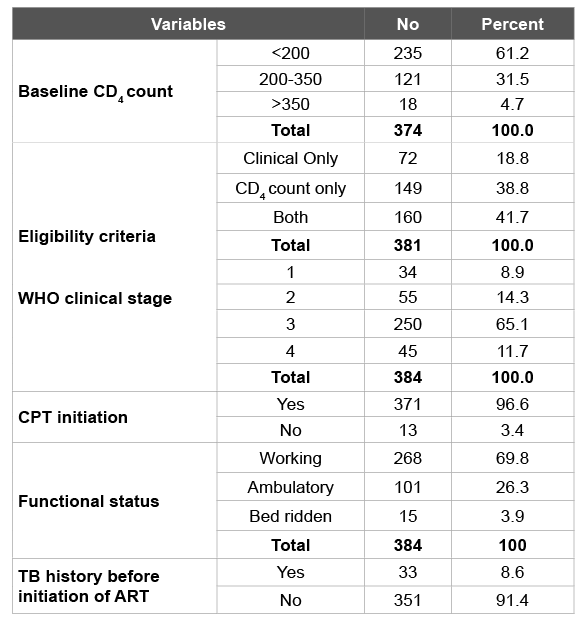
Table 2: Distribution of baseline immunological and clinical characteristics of adult HIV patients started ART from September 2010 to August 2011 in AHMC ART clinic, Oromia regional state, Ethiopia.
Sixty percent of the participant had at least one opportunistic infection. The most common OIs were oral candidiasis 159(41.4%) and unexplained chronic diarrhea 39(10.1%). Herpes zoster 34(8.8%) and pulmonary TB 33(8.6%) were the third and the fourth frequent OIs (Table 3).
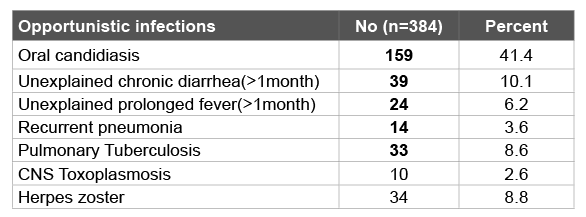
Table 3: Common OIs among adult HIV patients started on ART from September 2010 to August 2011 in AHMC ART clinic, Oromia regional state, Ethiopia.
Of 384 patients included in this study, 227 (59.1%) completed the follow up period, 91(23.7%) were lost from follow up, 49 (12.8%) were transferred out to other health facility and 17 (4.4%) died (Figure 1).
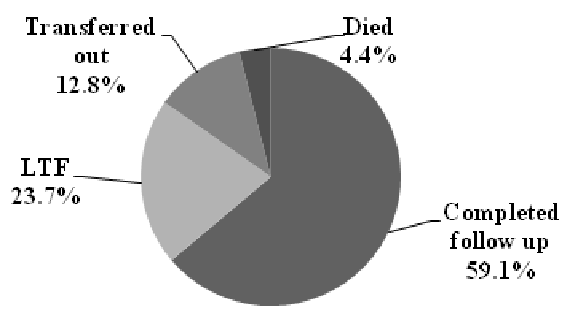
Figure 1: Follow up status at the end of three year follow-up among adult HIV patients started on ART from September 2010 to August 2011 in AHMC ART clinic, Oromia regional state, Ethiopia.
Overall 384 patients contributed 792.4-person year of observation (PYO). The mortality rate was 2.1/100 PYO (17 deaths/792.4 PYO). Fifty eight percent of deaths occurred in the first month of ART initiation. The rate of LTF was 11.5/100 PYO (91 LTF/792.4 PYO). The median survival time for the cohort was 24 months while the median survival time for dead and LTF cases were 1 month and 3 months respectively (Figure 2).
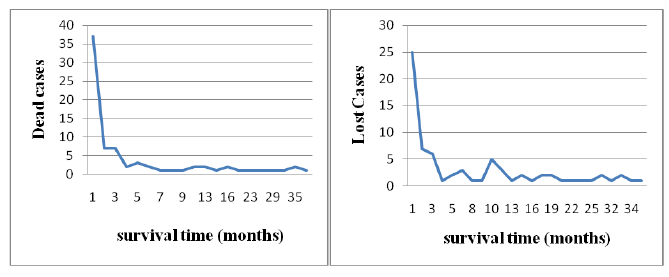
Figure 2: Comparative Distribution of survival time between dead cases & LTF adult HIV patients started on ART from September 2010 to August 2011 in AHMC ART clinic, Oromia regional state, Ethiopia.
The distribution of failure time between event cases and lost cases was almost similar. The median baseline CD4 count for lost cases was 121 cells/ mm3 while that of event cases was 117 cells/mm3 . Moreover, 76(83.5%) and 11(64.7%) of the lost cases and event cases were having WHO clinical stage 3/4 respectively. Similarly, 64(72.7%) of LTF and 12(70.6%) of event cases had at least one opportunistic infection history.
To identify the predictors of survival, two models were used. The first model (real case assumption) used confirmed dead cases in which 17 cases were events and the second model (Worst case assumption) was the worst scenario in which 91 lost cases were considered as event cases in addition to real deaths.
In model I adjusted Cox-regression analysis, WHO clinical stages 3/4 patients were three times higher risk of mortality than clinical stage 1/2 patients (HR 3.84, 90% CI 1.22-12.05). In addition, ambulatory and bed ridden patients were 1.9 (HR: 1.9; CI: 1.21, 3.05) and 4.8 (HR: 4.8; CI: 2.37, 10.08) times higher risk of death as compared to working functional status respectively (Table 4).
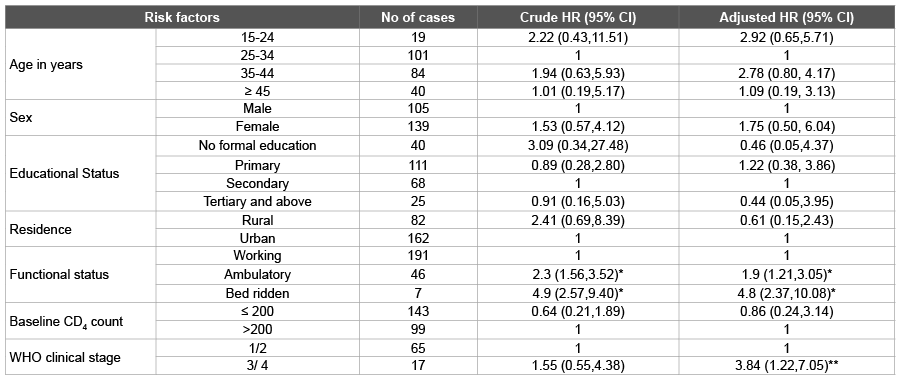
Table 4: Cox-proportional hazard model for possible risk factors of mortality among adult HIV patients started on ART from September 2010 to August 2011 in AHMC ART clinic, Oromia regional state, Ethiopia (Model I).
Adjusted Cox-regression analysis in model II showed that patients who had no formal education (HR:2.45; 95% CI:1.36, 4.40), divorced marital status (HR:1.57; 90%CI:1.03, 2.47), ambulatory functional status (HR:1.84;95% CI:1.15,2.94) and bed ridden patients (HR:4.92; 95% CI :2.36,10.24) had higher risk of mortality (Table 5).
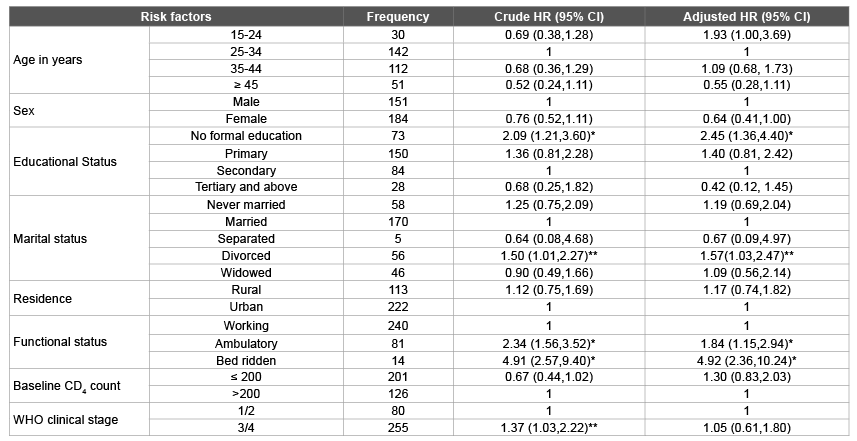
Table 5: Cox-proportional hazard model for possible risk factors of among adult HIV patients started ART from September 2010 to August 2011 in AHMC
ART clinic, Oromia regional state, Ethiopia (Model II).
*indicates significantly associated at P<0.05
**significantly associated at P<0.1.
The survival probability of AIDS patients increased by the advent of ART despite challenges like low asymptomatic screening and early treatment of HIV/AIDS cases. The sociodemographic and clinical characteristics of study participants were consistent with many other studies conducted in poor resource settings. More than half (56%) of the study participants were females with mean age of 33 years at first visit of ART clinic. There was statistically significant difference in mean age at first visit among sexes in which females were less than males. This implies that HIV/AIDS is affecting the productive age of the population particularly reproductive age mothers. This finding was consistent with study done in Assela and Shashemene Hospitals of Oromia region which reported young women were largely affected [12,13]. This is may be because of young women vulnerability to have older partners by forced and early marriage culture. Similarly, sex abuse among females may also possibly explain the observed difference.
More than half (61.2%) of participant had baseline CD4 count <200 cells/µl. The median CD4 count was 162 cells/µl. Similarly, 65.1% of the participants were clinical stage 3/4 at initial visit. About 30.2% of the participants were ambulatory or bed ridden. At least one opportunistic infection was identified among 60% of the participants. Other studies conducted in similar settings reported that HIV/AIDS patients visit ART clinic at advanced clinical stage. This is due to low access to ART services, stigma related to HIV and limited availability of VCT services in most areas in poor resource settings [12,14-16].
The overall mortality of the cohort was 2.1/100 PYO during three years follow up and more than half (58.8%) of the death were occurred within the first one months of ARV treatment initiation. The mortality rate was similar to other studies conducted in Harar town and Goba Hospital. These studies also reported WHO clinical stage 3/4 and lower CD4 count during initial visit were predictors of mortality among adult HIV/AIDS patients which is consistent information with this study [13,17]. On the other hand, the finding of this study is lower than the finding in Assela and Shashemene Hospitals [12]. The decrease in mortality in this study may be due to better awareness about HIV/AIDS care and improved care in the health facilities from time to time as well as eligibility criteria difference for ART initiation as those studies were conducted before years.
The rate of LTF cases was 11.5/100 PYO, which was higher than study done in Arba Minch Hospital of southern Ethiopia that reported LTF rate of 8.2/100 PYO. The median survival time for the study cohort was 24 months while that of dead and LTF cases was 1 month and 3 months respectively. Study done in Arba Minch reported 13.4% patients were lost from follow up [18]. Other studies also indicated, rate of loss to program reflects to a certain extent the degree of underestimation of mortality [19].
The distribution of failure time between event cases and lost cases was similar. The median baseline CD4 count for lost cases and event cases was 121 cell/mm3 and 117 cells/mm3 respectively. Moreover, 83.5% and 64.7% of the lost cases and event cases were having clinical stage 3/4 at initial visit respectively. Similarly, 72.7% of LTF and 70.6% of event cases had at least one opportunistic infection during their first visit to ART clinic. This showed that lost and event cases had almost similar baseline characteristics and larger proportion of these patients show similar advanced clinical characteristics during the first visit.
In real case assumption model, ambulatory and bedridden baseline functional status, baseline CD4 count <200 cell/mm3 , and WHO clinical stage 3/4 increase the risk of mortality. Study done in Addis Ababa Zewditu Memorial Hospital, Ethiopia also showed that starting ART at working functional status increases the likelihood of being working at the end of the study period with p<0.0001 [20]. This is due to the fact that patients initiating ARV treatment at advanced clinical stage suffer from treatment related complications and unforeseen OIs which increased risk of mortality.
In worst scenario model, socio demographic factors like lack of formal education and divorced marital status increase the risk of death. This is may be due to the fact that this group of population had minimum support and less knowledge to run life challenges wisely. Similarly, ambulatory and bedridden functional status also increases the risk of death. This is due to advanced disease stage during first visit leads to ART complications. This finding was similar with other study that reported not working due to illness, low CD4 count during ART initiation and WHO clinical stage 4 as predictors of mortality [21]. A study done Tikur Anbessa Hospital reported consistent finding [22]. Other studies reported similar finding that advanced clinical stage at ART initiation increase the risk of mortality.
Since this research used data from routine clinical records, some variables were not analyzed due to missing values.
More than half of the participants were females and higher proportion of females were younger than 35 years. The large proportions of patients were in advanced clinical stage at the initial visit. Majority of death and loss of cases occur within three months of ART initiation. Lost to follow up in this setting was higher which warrants strong emphasis on patient retention mechanisms. Factors like lack of formal education, being single, divorced, widowed, separated and advanced clinical stage at ART initiation increases the risk of mortality
Ethical clearance was secured from Adama Hospital Medical College institutional ethical review committee. The confidentiality of patients’ data was insured by collecting data using patient’s unique ART number rather than using name.
The authors declare that they have no competing interests.
TW: Conceived of the study, and participated in its design and coordination and draft the manuscript, AM: Participated in its design and coordination and draft the manuscript, TE: Was participated in the draft of manuscript,
GM: Was participated in the design of the study and drafts the manuscript. All authors read and approved the final manuscript.
We much appreciate Adama Hospital Medical College for funding.
Download Provisional PDF Here
Article Type: Research Article
Citation: Abebe TW, Chaka TE, Misgana GM, Adlo AM (2016) Determinants of Survival among Adults on Antiretroviral Therapy in Adama Hospital Medical College, Oromia Regional state, Ethiopia. J HIV AIDS 2(1): doi http://dx.doi. org/10.16966/2380-5536.117
Copyright: © 2016 Abebe TW, et al. This is an open-access article distributed under the terms of the Creative Commons Attribution License, which permits unrestricted use, distribution, and reproduction in any medium, provided the original author and source are credited.
Publication history:
All Sci Forschen Journals are Open Access